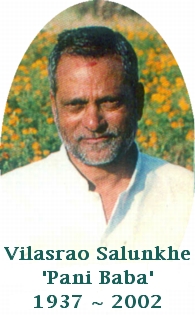In the early eighties when the cloth mill in which the villagers of Mahur were working closed down, they came together for their own water panchayat. Ten to 15 percent of the villagers who already had irrigated land have not joined the scheme. People living on the hilltop where the water could not be reached have also stayed away. As have carpenters and others doing different jobs. “Where the cost of development does not ensure returns, villagers have not joined in,” says Lakhsman Khedar, who works closely with Salunkhe to ensure that the scheme stays on line. Though the region received close to 1100 mm of rain annually there was no storage facility, villagers recall. Today it is wonderful to see the prosperity of Ramchandra Sripathi Chavan, one of Mahur’s early beneficiaries of the pani panchayat scheme. The old mud hut in which he lived till the eighties now serves as the godown for his crop of onions. A solid two-roomed cement house with galvanised iron sheets for roof is his new abode. A television set has been given pride of place.
Of the four acres of land that he and his brothers own, two acres are now irrigated through lift irrigation. Earlier he was dependant on the rains and grew just bajra and jowar. He was able to harvest just 5 to 6 quintals in a year and earned just Rs.2500. Today he grows a mix of crops and his income has soared.
Others from the village gathered to recount similar success stories. Niranjan Ganpat Rao Chavan and his brother have 12 acres of land. Now under the pani panchayat scheme 4.5 acres is irrigated. Earlier he grew groundnuts in the rainy season and bajra, jowar and rice and earned Rs.5000 to Rs.6000 in a year. Now he grows mogra, marigold and lilies in addition to wheat and vegetables and earns Rs.70,000 per acre of irrigated land.
Niranjan, an MA, LLB had left his village in 1984 and was working in offices in Ratnagiri and Pune and sending home money. In 1987 he returned to Mahur to look after the irrigated lands. Like him Satyawan Gole has returned from Mumbai to work on his fields at home. Paying a donation, he has been able to send his son to an engineering college.
Balasahib Chavan and his brothers own 11 acres of land of which three acres are under the pani panchayat scheme. Balasahib who studied till the 12th class is the village patkari, the man who operates the lift irrigation scheme, bills the villagers, collects payments and ensures that each member of the panchayat gets his due share of water. The pumps operate round the clock and Balasahib ensures that each acre gets water for three hours continuously. Though there is load shedding in the area, it is not as bad as it is in U.P., the villagers pointed out. Balasahib underwent special training on motor repair and electricity at Sashwath before taking charge in Mahur. He gets a salary of Rs.1500 as patkari. Every member of the panchayat contributes Rs.1000 a year towards maintenance. Balasahib who was earning Rs.9000 from his land now earns Rs.2 lakh a year. What is more, he has a special status in the village.

